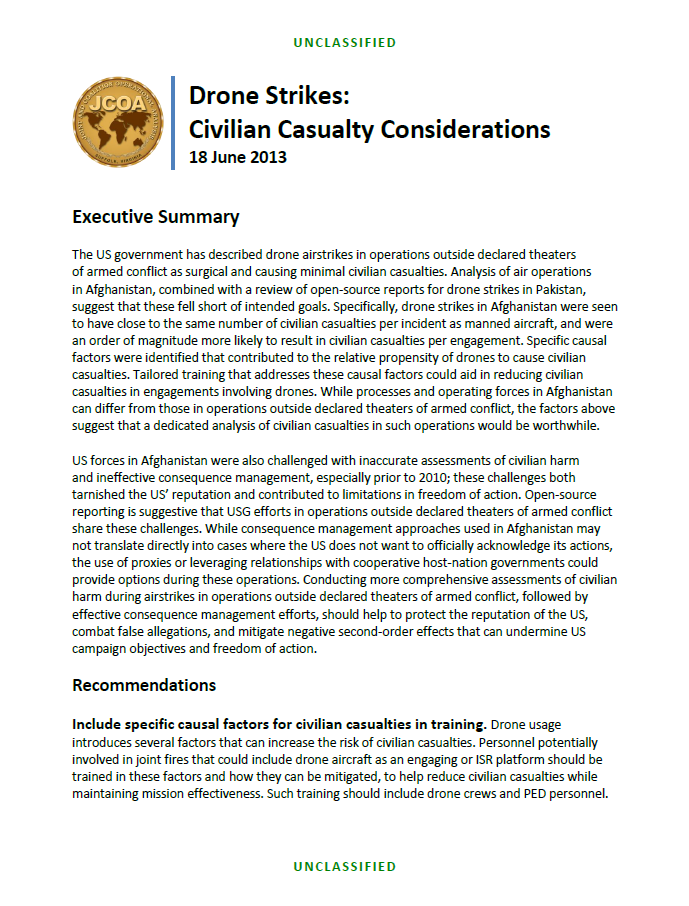The following is an executive summary of a larger report that is not available to the public. The summary was published in June 2013 by the CNA Corporation.
Drone Strikes: Civilian Casualty Considerations
- 2 pages
- June 18, 2013
The US government has described drone airstrikes in operations outside declared theaters of armed conflict as surgical and causing minimal civilian casualties. Analysis of air operations in Afghanistan, combined with a review of open-source reports for drone strikes in Pakistan, suggest that these fell short of intended goals. Specifically, drone strikes in Afghanistan were seen to have close to the same number of civilian casualties per incident as manned aircraft, and were an order of magnitude more likely to result in civilian casualties per engagement. Specific causal factors were identified that contributed to the relative propensity of drones to cause civilian casualties. Tailored training that addresses these causal factors could aid in reducing civilian casualties in engagements involving drones. While processes and operating forces in Afghanistan can differ from those in operations outside declared theaters of armed conflict, the factors above suggest that a dedicated analysis of civilian casualties in such operations would be worthwhile.
US forces in Afghanistan were also challenged with inaccurate assessments of civilian harm and ineffective consequence management, especially prior to 2010; these challenges both tarnished the US’ reputation and contributed to limitations in freedom of action. Open-source reporting is suggestive that USG efforts in operations outside declared theaters of armed conflict share these challenges. While consequence management approaches used in Afghanistan may not translate directly into cases where the US does not want to officially acknowledge its actions, the use of proxies or leveraging relationships with cooperative host-nation governments could provide options during these operations. Conducting more comprehensive assessments of civilian harm during airstrikes in operations outside declared theaters of armed conflict, followed by effective consequence management efforts, should help to protect the reputation of the US, combat false allegations, and mitigate negative second-order effects that can undermine US campaign objectives and freedom of action.
Recommendations
Include specific causal factors for civilian casualties in training. Drone usage introduces several factors that can increase the risk of civilian casualties. Personnel potentially involved in joint fires that could include drone aircraft as an engaging or ISR platform should be trained in these factors and how they can be mitigated, to help reduce civilian casualties while maintaining mission effectiveness. Such training should include drone crews and PED personnel.
Leverage civilian casualty consequence management lessons from Afghanistan.
Civilian casualties in Afghanistan limited USG freedom of action and necessitated an evolving approach to maintain effectiveness, including effective consequence management. Best practices and lessons from Afghanistan regarding civilian casualty consequence management can also apply to other USG efforts, including operations outside declared theaters of armed conflict. Deliberate efforts to improve civilian casualty consequence management during these operations should aid in reducing civilian casualties and avoiding negative second-order effects, such as the curtailing of freedom of action.
Conduct a review of civilian casualty levels in operations outside declared theaters of armed conflict. Airstrikes in support of operations outside declared theaters of armed conflict appear to have some common elements with operations in Afghanistan. This is likely to include several factors that increase the risk of civilian casualties. Operations outside declared theaters of armed conflict should be analyzed to identify current civilian casualty issues and point to additional areas where focus could help to reduce civilian casualties while maintaining mission effectiveness. This would benefit those operations by avoiding negative second-order effects, which can curtail freedom of action and undermine US objectives.
Review the process for classifying casualties as enemy combatants versus civilian casualties in operations outside declared theaters of armed conflict. While the US has stressed how drone strikes in Pakistan caused very few civilian deaths, this appears to contradict a number of independent investigations regarding these strikes. Review of the US process for classifying civilian casualties in operations outside declared theaters of armed conflict should aid in reconciling these disparate reports. In addition, this process could likely benefit from best practices and lessons for civilian casualty classification processes from Afghanistan.
Where appropriate, apply Afghanistan civilian casualty reduction best practices to operations outside declared theaters of armed conflict. ISAF and US forces in Afghanistan have made significant progress in reducing civilian casualties while maintaining mission effectiveness. A number of these best practices and lessons could be applied to the conduct of operations outside declared theaters of armed conflict. These best practices and lessons should be shared with USG elements conducting these campaigns, including both leaders and elements responsible for executing operations.

